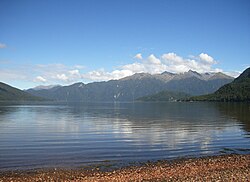Lake Hauroko
| Lake Hauroko | |
|---|---|
 |
|
| Location | Fiordland National Park, Southland District, Southland, South Island |
| Coordinates | 46°00′S 167°20′E / 46.000°S 167.333°ECoordinates: 46°00′S 167°20′E / 46.000°S 167.333°E |
| Primary outflows | Wairaurahiri River |
| Basin countries | New Zealand |
| Max. length | 40 km (25 mi) |
| Surface area | 63 km2 (24 sq mi) |
| Max. depth | 462 m (1,516 ft) |
| Islands | 1 (Mary Island) |
Lake Hauroko is located in a mountain valley in Fiordland National Park in the South Island of New Zealand. The long S-shaped lake is 30 kilometres in length and covers an area of 63 km². The surface is at an altitude of 150 metres (490 ft) above sea level, and the lake is 462 metres (1,516 ft) deep. It is New Zealand's deepest lake.
One of the country's southernmost lakes, it is 35 kilometres northwest of Tuatapere, between the similarly-sized lakes Monowai and Poteriteri. It drains via the 20 kilometre-long Wairaurahiri River into Foveaux Strait 10 kilometres to the west of Te Waewae Bay. The name Hauroko is of Māori origin and translates into English as "sounding wind".
The only island on the lake, Mary Island, is the focus of several local myths, including one that the island is subject to a Māori curse. Such stories are dismissed by local Māori. The island is famous for the discovery of a burial site of a Māori woman in 1967, who is known as "the lady of the lake" by Southland locals. The burial site is in a cave on the eastern side of the island. Believed to have been placed on the burial site sometime between the late 16th century and 17th century, possibly around 1660, the woman was laid to rest wearing a flax cloak with a dog skin collar weka feather edging around her neck, and was seated upright on a bier made of sticks and leaves. The reasons for the burial in this manner are uncertain, although it has been suggested that these burials were to either make sure the remains were protected from desecration by enemies, or to protect living descendants from a dangerous "tapu" (a Māori word that means sacred, forbidden or taboo) that the ancient Māori may have believed the ancestral bones possessed. This led to the belief that this woman was of high-ranking status, which was later discovered through an archaeological investigation that she was a chieftainess of the ngati moimoi tribe. The burial still remains on the island today, with a grille made of steel and wire mesh ensuring that interested people can still view the burial, but the woman will remain untouched.
...
Wikipedia
